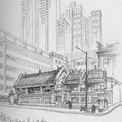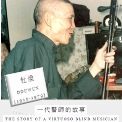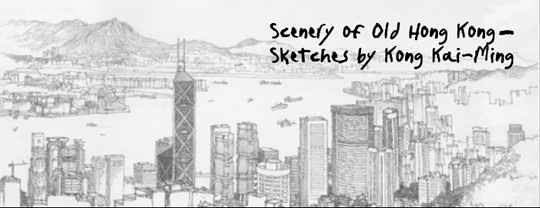Xiaoxiang Shuiyun (Waters and Mists of the Rivers Xiao and Xiang) (excerpt)
The earliest extant notation of this piece can be found in the Shenqi Mipu (Mysterious Manuscript) (1425). Attributed to the qin master, Guo Chuwang of the Southern Song Dynasty, the piece paints a picture of hills and rivers shimmering in the misty light. This recording is played based on Ziyuantang Qinpu (1802) and is played by Lee Chun-yuen, Otto with his own made Lianzhu Style Qin (metal strings).| Date | 2013 |
| Maker's Note | This is the second qin I made as part of my apprenticeship. Both the top and the bottom boards have been covered in black lacquer, featuring chestnut brown speckles in some areas. The qin top is particularly smooth to the touch. It has a heavy, solid, and antique timbre that is smooth and clear. |
| People | Lee Chun-yuen, Otto |
| Material Type | Audio |
| Collection | The Legend of Silk and Wood: A Hong Kong Qin Story |
| Source | Intangible Cultural Heritage Office and Hong Kong Heritage Museum |
| Repository | Intangible Cultural Heritage Office |
| Note to Copyright | Permission for use in Hong Kong Memory is given by Intangible Cultural Heritage Office and Hong Kong Heritage Museum |
| Accession No. | lcs-hkqs-0222 |


Wuye Wu Qiufeng (Parasol Leaves Dancing in the Autumn Breeze)
This piece first appeared in the Qinxue Xinsheng (Study and Aspirations of the Qin) (1664) by Zhuang Zhenfung of the Qing Dynasty and is the most widely played piece among the composer’s fourteen works. It has a delicate melody which evocatively describes the sound of falling leaves in an autumn breeze. In this performance, the piece is played based on Qing Rui's heirloom manuscripts and is played by Yung Hak-chi, Hammond with his own made Keng'er Qin (metal strings).


Yangguan Sandie (Parting at Yangguan)
The earliest version of this piece of qin music appeared in the Zheyin Shizi Qinpu (Qin Songs in Zhejiang Dialect) (1491). The lyrics were developed from a famous poem by the Tang poet, Wang Wei, titled Song Yuan’er Shi Anxi (Seeing Yuan Er Off as Commissioner to Anxi). Many other versions appeared later, but these were either shortened or extended as the arrangers or musicians saw fit. This version is derived from the Yinyinshi Qinpu (Yinyinshi Manuscript) (2000) of Tsar Teh-yun. The music opens slowly, and then accelerates. As the emotions escalate, it changes to rubato before it comes to a more relaxed and muted closing, ending on harmonic notes. The undulating melodic line attempts to recreate the changing emotions of dear friends at parting. This recording is played by Ng Ying-wai with her own made Songtao Qin (synthetic fibre strings).


Pingsha Luoyan (Wild Geese Landing on Sand)
This piece first appeared in a manuscript of the late Ming Dynasty. One of the most widely played pieces of the last three hundred years, it exists in scores of notational versions. The version in the Tianwenge Qinpu (Tianwenge Qin Handbook) (1876) bears a note that suggests programmatic content: “The autumnal sky is high and the air is clear; the wind is calm and the sand is smooth; the clouds stretch for ten thousand miles; the wild geese fly freely in the sky, sharing the thoughts of this wanderer.” This recording is played based on Jiao’an Qinpu (Jiao’an Qin Handbook) (1868) and is played by Siu Yat-tung with his own made Zhongni Style Qin (silk strings).
Xiaoxiang Shuiyun (Waters and Mists of the Rivers Xiao and Xiang) (excerpt)
The earliest extant notation of this piece can be found in the Shenqi Mipu (Mysterious Manuscript) (1425). Attributed to the qin master, Guo Chuwang of the Southern Song Dynasty, the piece paints a picture of hills and rivers shimmering in the misty light. This recording is played based on Ziyuantang Qinpu (1802) and is played by Lee Chun-yuen, Otto with his own made Lianzhu Style Qin (metal strings).| Date | 2013 |
| Material Type | Audio |
| People | Lee Chun-yuen, Otto |
| Collection | The Legend of Silk and Wood: A Hong Kong Qin Story |
| Source | Intangible Cultural Heritage Office and Hong Kong Heritage Museum |
| Repository | Intangible Cultural Heritage Office |
| Note to Copyright | Permission for use in Hong Kong Memory is given by Intangible Cultural Heritage Office and Hong Kong Heritage Museum |
| Accession No. | lcs-hkqs-0222 |


Wuye Wu Qiufeng (Parasol Leaves Dancing in the Autumn Breeze)
This piece first appeared in the Qinxue Xinsheng (Study and Aspirations of the Qin) (1664) by Zhuang Zhenfung of the Qing Dynasty and is the most widely played piece among the composer’s fourteen works. It has a delicate melody which evocatively describes the sound of falling leaves in an autumn breeze. In this performance, the piece is played based on Qing Rui's heirloom manuscripts and is played by Yung Hak-chi, Hammond with his own made Keng'er Qin (metal strings).


Yangguan Sandie (Parting at Yangguan)
The earliest version of this piece of qin music appeared in the Zheyin Shizi Qinpu (Qin Songs in Zhejiang Dialect) (1491). The lyrics were developed from a famous poem by the Tang poet, Wang Wei, titled Song Yuan’er Shi Anxi (Seeing Yuan Er Off as Commissioner to Anxi). Many other versions appeared later, but these were either shortened or extended as the arrangers or musicians saw fit. This version is derived from the Yinyinshi Qinpu (Yinyinshi Manuscript) (2000) of Tsar Teh-yun. The music opens slowly, and then accelerates. As the emotions escalate, it changes to rubato before it comes to a more relaxed and muted closing, ending on harmonic notes. The undulating melodic line attempts to recreate the changing emotions of dear friends at parting. This recording is played by Ng Ying-wai with her own made Songtao Qin (synthetic fibre strings).


Pingsha Luoyan (Wild Geese Landing on Sand)
This piece first appeared in a manuscript of the late Ming Dynasty. One of the most widely played pieces of the last three hundred years, it exists in scores of notational versions. The version in the Tianwenge Qinpu (Tianwenge Qin Handbook) (1876) bears a note that suggests programmatic content: “The autumnal sky is high and the air is clear; the wind is calm and the sand is smooth; the clouds stretch for ten thousand miles; the wild geese fly freely in the sky, sharing the thoughts of this wanderer.” This recording is played based on Jiao’an Qinpu (Jiao’an Qin Handbook) (1868) and is played by Siu Yat-tung with his own made Zhongni Style Qin (silk strings).
Xiaoxiang Shuiyun (Waters and Mists of the Rivers Xiao and Xiang) (excerpt)
The earliest extant notation of this piece can be found in the Shenqi Mipu (Mysterious Manuscript) (1425). Attributed to the qin master, Guo Chuwang of the Southern Song Dynasty, the piece paints a picture of hills and rivers shimmering in the misty light. This recording is played based on Ziyuantang Qinpu (1802) and is played by Lee Chun-yuen, Otto with his own made Lianzhu Style Qin (metal strings).| Date | 2013 |
| People | Lee Chun-yuen, Otto |
| Material Type | Audio |
| Collection | The Legend of Silk and Wood: A Hong Kong Qin Story |
| Source | Intangible Cultural Heritage Office and Hong Kong Heritage Museum |
| Repository | Intangible Cultural Heritage Office |
| Note to Copyright | Permission for use in Hong Kong Memory is given by Intangible Cultural Heritage Office and Hong Kong Heritage Museum |
| Accession No. | lcs-hkqs-0222 |


Wuye Wu Qiufeng (Parasol Leaves Dancing in the Autumn Breeze)
This piece first appeared in the Qinxue Xinsheng (Study and Aspirations of the Qin) (1664) by Zhuang Zhenfung of the Qing Dynasty and is the most widely played piece among the composer’s fourteen works. It has a delicate melody which evocatively describes the sound of falling leaves in an autumn breeze. In this performance, the piece is played based on Qing Rui's heirloom manuscripts and is played by Yung Hak-chi, Hammond with his own made Keng'er Qin (metal strings).


Yangguan Sandie (Parting at Yangguan)
The earliest version of this piece of qin music appeared in the Zheyin Shizi Qinpu (Qin Songs in Zhejiang Dialect) (1491). The lyrics were developed from a famous poem by the Tang poet, Wang Wei, titled Song Yuan’er Shi Anxi (Seeing Yuan Er Off as Commissioner to Anxi). Many other versions appeared later, but these were either shortened or extended as the arrangers or musicians saw fit. This version is derived from the Yinyinshi Qinpu (Yinyinshi Manuscript) (2000) of Tsar Teh-yun. The music opens slowly, and then accelerates. As the emotions escalate, it changes to rubato before it comes to a more relaxed and muted closing, ending on harmonic notes. The undulating melodic line attempts to recreate the changing emotions of dear friends at parting. This recording is played by Ng Ying-wai with her own made Songtao Qin (synthetic fibre strings).


Pingsha Luoyan (Wild Geese Landing on Sand)
This piece first appeared in a manuscript of the late Ming Dynasty. One of the most widely played pieces of the last three hundred years, it exists in scores of notational versions. The version in the Tianwenge Qinpu (Tianwenge Qin Handbook) (1876) bears a note that suggests programmatic content: “The autumnal sky is high and the air is clear; the wind is calm and the sand is smooth; the clouds stretch for ten thousand miles; the wild geese fly freely in the sky, sharing the thoughts of this wanderer.” This recording is played based on Jiao’an Qinpu (Jiao’an Qin Handbook) (1868) and is played by Siu Yat-tung with his own made Zhongni Style Qin (silk strings).
Xiaoxiang Shuiyun (Waters and Mists of the Rivers Xiao and Xiang) (excerpt)
The earliest extant notation of this piece can be found in the Shenqi Mipu (Mysterious Manuscript) (1425). Attributed to the qin master, Guo Chuwang of the Southern Song Dynasty, the piece paints a picture of hills and rivers shimmering in the misty light. This recording is played based on Ziyuantang Qinpu (1802) and is played by Lee Chun-yuen, Otto with his own made Lianzhu Style Qin (metal strings).| Interview Date | Date | 2013 |
| People | Lee Chun-yuen, Otto | |
| Material Type | Audio | |
| Collection | The Legend of Silk and Wood: A Hong Kong Qin Story | |
| Source | Intangible Cultural Heritage Office and Hong Kong Heritage Museum | |
| Repository | Intangible Cultural Heritage Office | |
| Note to Copyright | Permission for use in Hong Kong Memory is given by Intangible Cultural Heritage Office and Hong Kong Heritage Museum | |
| Accession No. | lcs-hkqs-0222 |


Wuye Wu Qiufeng (Parasol Leaves Dancing in the Autumn Breeze)
This piece first appeared in the Qinxue Xinsheng (Study and Aspirations of the Qin) (1664) by Zhuang Zhenfung of the Qing Dynasty and is the most widely played piece among the composer’s fourteen works. It has a delicate melody which evocatively describes the sound of falling leaves in an autumn breeze. In this performance, the piece is played based on Qing Rui's heirloom manuscripts and is played by Yung Hak-chi, Hammond with his own made Keng'er Qin (metal strings).


Yangguan Sandie (Parting at Yangguan)
The earliest version of this piece of qin music appeared in the Zheyin Shizi Qinpu (Qin Songs in Zhejiang Dialect) (1491). The lyrics were developed from a famous poem by the Tang poet, Wang Wei, titled Song Yuan’er Shi Anxi (Seeing Yuan Er Off as Commissioner to Anxi). Many other versions appeared later, but these were either shortened or extended as the arrangers or musicians saw fit. This version is derived from the Yinyinshi Qinpu (Yinyinshi Manuscript) (2000) of Tsar Teh-yun. The music opens slowly, and then accelerates. As the emotions escalate, it changes to rubato before it comes to a more relaxed and muted closing, ending on harmonic notes. The undulating melodic line attempts to recreate the changing emotions of dear friends at parting. This recording is played by Ng Ying-wai with her own made Songtao Qin (synthetic fibre strings).


Pingsha Luoyan (Wild Geese Landing on Sand)
This piece first appeared in a manuscript of the late Ming Dynasty. One of the most widely played pieces of the last three hundred years, it exists in scores of notational versions. The version in the Tianwenge Qinpu (Tianwenge Qin Handbook) (1876) bears a note that suggests programmatic content: “The autumnal sky is high and the air is clear; the wind is calm and the sand is smooth; the clouds stretch for ten thousand miles; the wild geese fly freely in the sky, sharing the thoughts of this wanderer.” This recording is played based on Jiao’an Qinpu (Jiao’an Qin Handbook) (1868) and is played by Siu Yat-tung with his own made Zhongni Style Qin (silk strings).
Xiaoxiang Shuiyun (Waters and Mists of the Rivers Xiao and Xiang) (excerpt)
The earliest extant notation of this piece can be found in the Shenqi Mipu (Mysterious Manuscript) (1425). Attributed to the qin master, Guo Chuwang of the Southern Song Dynasty, the piece paints a picture of hills and rivers shimmering in the misty light. This recording is played based on Ziyuantang Qinpu (1802) and is played by Lee Chun-yuen, Otto with his own made Lianzhu Style Qin (metal strings).| Interviewee | Lee Chun-yuen, Otto |
| Date | 2013 |
| Material Type | Audio |
| Collection | The Legend of Silk and Wood: A Hong Kong Qin Story |
| Source | Intangible Cultural Heritage Office and Hong Kong Heritage Museum |
| Repository | Intangible Cultural Heritage Office |
| Note to Copyright | Permission for use in Hong Kong Memory is given by Intangible Cultural Heritage Office and Hong Kong Heritage Museum |
| Accession No. | lcs-hkqs-0222 |


Wuye Wu Qiufeng (Parasol Leaves Dancing in the Autumn Breeze)
This piece first appeared in the Qinxue Xinsheng (Study and Aspirations of the Qin) (1664) by Zhuang Zhenfung of the Qing Dynasty and is the most widely played piece among the composer’s fourteen works. It has a delicate melody which evocatively describes the sound of falling leaves in an autumn breeze. In this performance, the piece is played based on Qing Rui's heirloom manuscripts and is played by Yung Hak-chi, Hammond with his own made Keng'er Qin (metal strings).


Yangguan Sandie (Parting at Yangguan)
The earliest version of this piece of qin music appeared in the Zheyin Shizi Qinpu (Qin Songs in Zhejiang Dialect) (1491). The lyrics were developed from a famous poem by the Tang poet, Wang Wei, titled Song Yuan’er Shi Anxi (Seeing Yuan Er Off as Commissioner to Anxi). Many other versions appeared later, but these were either shortened or extended as the arrangers or musicians saw fit. This version is derived from the Yinyinshi Qinpu (Yinyinshi Manuscript) (2000) of Tsar Teh-yun. The music opens slowly, and then accelerates. As the emotions escalate, it changes to rubato before it comes to a more relaxed and muted closing, ending on harmonic notes. The undulating melodic line attempts to recreate the changing emotions of dear friends at parting. This recording is played by Ng Ying-wai with her own made Songtao Qin (synthetic fibre strings).


Pingsha Luoyan (Wild Geese Landing on Sand)
This piece first appeared in a manuscript of the late Ming Dynasty. One of the most widely played pieces of the last three hundred years, it exists in scores of notational versions. The version in the Tianwenge Qinpu (Tianwenge Qin Handbook) (1876) bears a note that suggests programmatic content: “The autumnal sky is high and the air is clear; the wind is calm and the sand is smooth; the clouds stretch for ten thousand miles; the wild geese fly freely in the sky, sharing the thoughts of this wanderer.” This recording is played based on Jiao’an Qinpu (Jiao’an Qin Handbook) (1868) and is played by Siu Yat-tung with his own made Zhongni Style Qin (silk strings).








